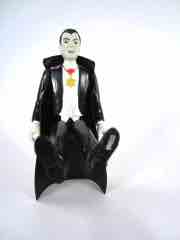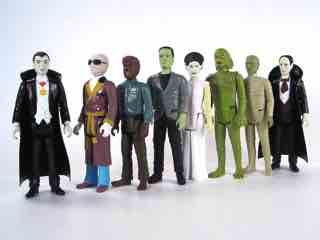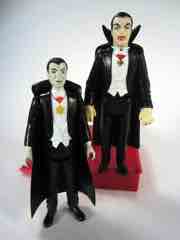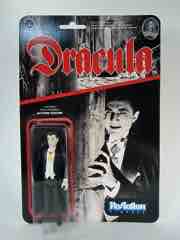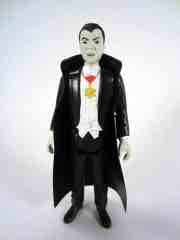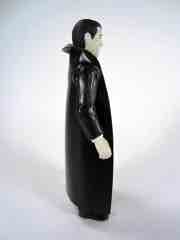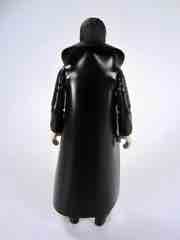Funko Universal Monsters Dracula Funko, 2014
Day #1,094: January 13, 2015
Dracula Dig the Vinyl Cape
Universal Monsters ReAction Figure No. 4086 Manufacturer: Funko Includes: Vinyl cape! Action Feature: n/a Retail: est. $9.99 Availability: September 2014 Other: No foot peg holes
PREVIOUS
RSS NEXT
Dracula only appeared in two movies (and other places) and helped instill the seemingly endless fascination with vampires in popular culture. Along with zombies, it's a safe bet that in almost any genre show they're going to come across some sort of vampire thing. Maybe Greek Vampires. Maybe Space Vampires. Perhaps Salt Vampires. It's going to happen largely thanks to the surprisingly unnerving performance in the 1931 film. The figure does a good job of picking up many of the significant.shtmlects of his costume, but does a rotten job on getting the head right. The back of the packaging is stamped with the Lugosi licensing logo, but (and this is important for those of you who bought figures in the 1990s and earlier) the Lugosi stamp of approval wasn't always there. Sometimes you have the character's license, but not the actor, and in this case the packaging says they have both. But that ain't Bela. Back in the 1980s, it could go either way, so let's say this was a conscious choice.
1990s Burger King counterpart . Other than the head, cape, and skin tone, they're remarkably similar albeit clearly sculpted at different times by different people with different goals. The fast food Drac has zero similarity to the movie actor's head, and I guess if you put the two side by side little details like mouth lines and the widow's peak do seem to vaguely recall the legendary Lugosi. The head proportions don't match, but it's still quite expressive - this is an older guy, mouth agape with piercing eyes and fairly restrained deco for the face. The white teeth and dark inner maw feel like departures from how an old figure might look, but white fangs on white skin just wouldn't read well as a vampire - so it's a sensible choice.
Dracula's vinyl cape is just like that of the Phantom or Darth Vader, a tight fit that looks weird to modern eyes. As a kid I never much cared for the vinyl cape, but when trying to replicate a key look from 1978-1980 it's pretty essential. The outfit itself carries the same basic design elements that his suit seems contractually obligated to bring, resulting in a clean, consistent look among most Universal Dracula licensed toys.
As a decent forgery of a 1980s Dracula based on the 1931 design, this is good. The figure's joints are nice and tight, nothing falls apart, and the paint is even throughout. It's a little too good, feeling more like a lost prototype than an actual lost toy. I like it, I like their design choices by and large, but it would have been awesome to see a "ReAction" take on Bela's rounder head. As it stands, this is a fine Dracula figure and arguably one of the better (if not the best) in this scale, but if they felt like doing Dracula 2.0 tomorrow I'd probably throw down a few bucks for that too. For ten bucks, it's fun if you're a child of the 1970s or 1980s. I like it enough to figure out how to display it, which is pretty high praise for figures these days when (as our collections grow) storage seems to trump a lot of other considerations. Like enjoyment.
--Adam Pawlus
Additional Images
See more Super 7 and Funko x Super 7 figures in Figure of the Day:Day 792: Super 7 ALIEN SDCC Exclusive Sales Samples Day 821: Super7 x Funko Alien ReAction Ripley Day 844: Super7 x Funko Alien ReAction Dallas Day 852: Super7 x Funko Alien ReAction Alien Day 857: Super7 x Funko Alien ReAction Kane in Space Suit Day 861: Super7 x Funko Alien ReAction Ash Day 945: Super7 x Funko The Rocketeer ReAction Rocketeer Action Figure Day 945: Super7 x Funko Predator (Invisible, Bloody) Action Figure Day 985: Funko Back to the Future Marty McFly ReAction Figure Day 1001: Funko Nightmare Before Christmas Jack Skellington (Early Bird Figure) ReAction Figure Day 1,005: Funko Universal Monsters The Mummy ReAction Figure Day 1,008: Funko Back to the Future George McFly ReAction Figure Day 1,008: Funko Back to the Future Doc Brown ReAction Figure Day 1,029: Super7 x Funko Predator (Attack Mode) ReAction Figure Day 1,037: Funko Nightmare Before Christmas Sally ReAction Figure Day 1,038: Funko Universal Monsters Creature from the Black Lagoon ReAction Figure Day 1,039: Funko Universal Monsters The Invisible Man ReAction Figure Day 1,040: Funko Universal Monsters The Phantom of the Opera ReAction Figure Day 1,041: Funko Universal Monsters The Wolf Man ReAction Figure Day 1,042: Funko Universal Monsters The Bride of Frankenstein ReAction Figure Day 1,059: Funko Predator (Masked) ReAction Figure Day 1,068: Funko Universal Monsters Frankenstein's Monster ReAction Figure Day 1,078: Funko Back to the Future Biff Tannen ReAction Figure Day 1,082: Funko T800 Endoskeleton (Chrome) ReAction Figure Day 1,094: Funko Universal Monsters Dracula ReAction Figure Day 1,059: Funko Predator (Masked) ReAction Figure Day 1,102: Funko Predator (Unmasked) ReAction Figure Day 1,108: Funko Universal Monsters The Invisible Man Day 1,108: Funko Universal Monsters The Invisible Man Clear Entertainment Earth Exclusive Day 1,111: Funko Predator (Glow Version) ReAction Figure Day 1,117: Funko The Terminator Sarah Connor ReAction Figure Day 1,133: Funko The Terminator (Tech Noir Jacket) ReAction Figure Day 1,138: Funko Pulp Fiction Mia Wallace ReAction Figure Day 1,149: Super7 x Funko Alien Egg Chamber Action Playset Day 1,183: Super7 x Funko Alien ReAction Alien (with Metallic Flesh) Day 1,187: Funko Predator (Invisible) ReAction Figure Day 1,199: Super7 x Funko Alien ReAction Ripley (Spacesuit) Day 1,208: Funko Predator (Thermal Vision) ReAction Figure Day 1,211: Funko The Fifth Element Leeloo ReAction Figure Day 1,217: Funko The Fifth Element Diva Plavalaguna ReAction Figure Day 1,222: Funko The Fifth Element Korben Dallas ReAction Figure Day 1,227: Funko The Fifth Element Mangalore ReAction Figure Day 1,236: Funko Gremlins Mogwai Stripe ReAction Figure Day 1,244: Funko The Fifth Element Ruby Rhod ReAction Figure Day 1,250: Super7 M.O.T.U.S.C.L.E. Set B Day 1,252: Funko The Fifth Element Zorg ReAction Figure Day 1,263: Super7 M.O.T.U.S.C.L.E. Set A Day 1,267: Funko The Fifth Element Leeloo (Straps Costume) ReAction Figure Day 1,272: Super7 x Funko Alien ReAction Kane (Chestburster) Day 1,275: Funko Gremlins Billy Peltzer ReAction Figure Day 1,277: Super7 x Funko Alien ReAction Kane (Facehugger) Day 1,286: Funko Nightmare Before Christmas Behemoth Day 1,288: Super7 M.O.T.U.S.C.L.E. Set C Day 1,295: Funko Nightmare Before Christmas Mayor Day 1,302: Super7 M.O.T.U.S.C.L.E. SDCC Promo Skeletor Day 1,327: Super7 x Funko Alien ReAction Nostromo Crew (Dallas, Kane, Lambert) Day 1,333: Funko Gremlins Cinema Gremlin ReAction Figure Day 1,342: Funko Gremlins Gremlin Stripe ReAction Figure Day 1,358: Funko Gremlins Bandit Gremlin ReAction Figure Day 1,628: Super7 Masters of the Universe M.U.S.C.L.E. Series 2 Set C Day 1,633: Super7 Masters of the Universe M.U.S.C.L.E. Series 2 Set B Day 1,637: Funko E.T. The Extra-Terrestrial Elliot, E.T., and Gertie ReAction Figures Day 1,639: Super7 Masters of the Universe M.U.S.C.L.E. Series 2 Set D Day 1,639: Super7 Masters of the Universe M.U.S.C.L.E. Series 2 Set A Day 1,656: Super7 Alien M.U.S.C.L.E. Set A Day 1,676: Super7 Alien M.U.S.C.L.E. Set C Day 1,686: Super7 Alien M.U.S.C.L.E. Set B Day 1,693: Super7 Alien M.U.S.C.L.E. Set D Day 1,801: Super7 Street Fighter II M.U.S.C.L.E. Set A Day 1,817: Super7 Street Fighter II M.U.S.C.L.E. Set B Day 1,834: Super7 Street Fighter II M.U.S.C.L.E. Set D Day 1,840: Super7 Masters of the Universe M.U.S.C.L.E. Series 3 Set D Day 1,846: Super7 Aliens M.U.S.C.L.E. Set E Day 1,843: Super7 Masters of the Universe M.U.S.C.L.E. Series 3 Set E Day 1,857: Super7 Street Fighter II M.U.S.C.L.E. Set C Day 1,862: Super7 Masters of the Universe M.U.S.C.L.E. Series 3 Set C Day 1,864: Super7 Aliens M.U.S.C.L.E. Set A Day 1,877: Super7 Masters of the Universe M.U.S.C.L.E. Series 3 Set F Day 1,881: Super7 Mega Man M.U.S.C.L.E. Series 1 Set B Day 1,884: Super7 Aliens M.U.S.C.L.E. Set D Day 1,894: Super7 Mega Man M.U.S.C.L.E. Series 1 Set D Day 1,904: Super7 Mega Man M.U.S.C.L.E. Series 1 Set A Day 1,914: Super7 Mega Man M.U.S.C.L.E. Series 1 Set C Day 1,920: Super7 Halloween Series Nosferatu Glow in the Dark Day 1,922: Super7 Masters of the Universe M.U.S.C.L.E. Series 3 Set B Day 1,937: Super7 Masters of the Universe M.U.S.C.L.E. Series 3 Set A Day 2,161: Super7 Masters of the Universe Transforming He-Man Action Figure Day 2,211: Super7 Toxic Crusaders Glow in the Dark Toxie Action Figure Day 2,235: Super7 Ultimates Voltron Action Figure Day 2,237: Super7 Teenage Mutant Ninja Turtles Ultimates Raphael Action Figure Day 2,253: Super7 Teenage Mutant Ninja Turtles Ultimates Foot Soldier Action Figure Day 2,358: Super7 Killer Bootlegs Rhamnusia's Revenge Action Playset with Draco Knuckleduster and Phantom Starkiller Action Figures Day 2,388: Super7 Teenage Mutant Ninja Turtles Ultimates Glow-in-the-Dark Mutagen Man Action Figure Day 2,454: Super7 Metropolis Silver Maria ReAction Figure Day 2,458: Super7 G.I. Joe Red Ninja ReAction Figure Day 2,465: Super7 Godzilla Godzilla '54 (Glow-in-the-Dark) ReAction Figure Day 2,480: Super7 Transformers Grimlock G2 ReAction Figure Day 2,526: Super7 Vincent Price Master of Mayhem ReAction Figure Day 2,530: Super7 Godzilla Mechagodzilla (Glow-in-the-Dark) ReAction Figure Day 2,534: Super7 Planet of the Apes Mendez XXVI ReAction Figure Day 2,546: Super7 Planet of the Apes Cornelius ReAction Figure Day 2,554: Super7 Alien UCCSS Nostromo Action Figure Set 1 with Kane with Facehugger, Ripley with Jonesy, Ash with Removable Head Day 2,562: Super7 Universal Monsters The Mummy ReAction Figure Day 2,570: Super7 Universal Monsters The Metaluna Mutant ReAction Figure Day 2,577: Super7 Transformers Hot Rod ReAction Figure Day 2,590: Super7 Planet of the Apes General Aldo ReAction Figure Day 2,594: Super7 Mars Attacks Destroying A Dog ReAction Figure Day 2,598: Super7 Planet of the Apes Dr. Zaius ReAction Figure Day 2,606: Super7 Universal Monsters Official World Famous Super7 Monsters! Creature from the Black Lagoon (Super She Creature) Glow-in-the-Dark Day 2,610: Super7 Planet of the Apes Taylor ReAction Figure Day 2,626: Super7 Planet of the Apes Zira ReAction Figure Day 2,630: Super7 Universal Monsters The Metaluna Mutant ReAction Figure Day 2,634: Super7 Planet of the Apes General Ursus ReAction Figure Day 2,638: Super7 Universal Monsters Dracula ReAction Figure Day 2,642: Super7 Star Trek: The Next Generation Armus ReAction Figure Day 2,647: Super7 Devo Whip It Mark Mothersbaugh ReAction Figure Day 2,649: Super7 Universal Monsters Bride of Frankenstein ReAction Figure Day 2,652: Super7 Universal Monsters The Mummy (Costume Colors) ReAction Figure Day 2,655: Super7 Planet of the Apes Nova ReAction Figure Day 2,657: Super7 Universal Monsters The Wolf Man ReAction Figure Day 2,659: Super7 Devo Satisfaction Bob Casale ReAction Figure Day 2,661: Super7 Svengoolie Horror Host Icon ReAction Figure Day 2,671: Super7 Vampira Dark Goddess of Horror Day 2,679: Super7 Planet of the Apes Gorilla Soldier (Hunter) Day 2,687: Super7 Sesame Street Yip Yip Martians Day 2,699: Super7 Dungeons & Dragons Sacred Statue Day 2,703 Super7 Planet of the Apes Gorilla Soldier (Patrolman) ReAction Figure Day 2,705 Super7 Devo New Traditionalists Gerald Casale ReAction Figure Day 2,724: Super7 Universal Monsters Creature from the Black Lagoon (Costume Colors) ReAction Figure Day 2,727: Super7 Star Trek: The Next Generation Wesley Crusher ReAction Figure Day 2,731: Super7 Star Trek: The Next Generation Dr. Beverly Crusher ReAction Figure Day 2,775: Super7 Universal Monsters The Wolf Man (Costume Colors) ReAction Figure Day 2,791: Super7 Devo Freedom of Choice Bob Mothersbaugh ReAction Figure Day 2,794: Super7 Sesame Street Oscar the Grouch Day 2,815: Super7 Universal Monsters Creature from the Black Lagoon ReAction Figure Day 2,820: Super7 Godzilla Titanosaurus '75 ReAction Figure Day 2,827: Super7 Universal Monsters Mole People ReAction Figure Day 2,831: Super7 Godzilla Monster Island Mystery Box Godzilla '62 ReAction Figure Day 2,836: Super7 Universal Monsters The Invisible Man ReAction Figure Day 2,839: Super7 Godzilla Monster Island Mystery Box Mechagodzilla '74 ReAction Figure Day 2,842: Super7 SilverHawks Quicksilver ReAction Figure Day 2,845: Super7 Universal Monsters Frankenstein ReAction Figure Day 2,848: Super7 Micronauts Baron Karza ReAction+ Figure Day 2,857: Super7 SilverHawks Mon*Star ReAction Figure Day 2,872: Super7 Universal Monsters The Mummy Ardath Bey ReAction Figure Day 2,884: Super7 Universal Monsters Son of Frankenstein ReAction Figure Day 2,887: Super7 Planet of the Apes Astronaut Cornelius ReAction Figure Day 2,899: Super7 Masters of the Universe Scare Glow ReAction Figure Day 2,902: Super7 Star Trek: The Next Generation Guinan Day 2,906: Super7 Transformers Gold Armor Bumblebee ReAction Figure Day 2,923: Super7 Universal Monsters Frankenstein's Monster (Costume Colors) Day 2,929: Super7 Devo Booji Boy ReAction Figure Day 2,941: Super7 Universal Monsters Creature from the Black Lagoon ReAction+ Figure Day 2,947: Super7 Micronauts Microtron ReAction+ Figure
See more Universal Monsters , Horror , and Monsters figures in Figure of the Day:Day 76: Diamond Select Toys Black and White Wolfman Day 777: Playmates Toys Monster Force Creature from the Black Lagoon Day 883: Burger King Universal Monsters Wolf Man Cellar Dweller Action Figure Day 894: Burger King Universal Monsters Down for the Count Dracula Day 924: Burger King Universal Monsters Bolts and Volts Frankenstein Day 931: Burger King Universal Monsters Scary Squirter Featuring the Creature from the Black Lagoon Day 1,000: Funko Hikari Vinyl Freddy Funko (Creature from the Black Lagoon) Day 1,005: Funko Universal Monsters The Mummy ReAction Figure Day 1,038: Funko Universal Monsters Creature from the Black Lagoon ReAction Figure Day 1,039: Funko Universal Monsters The Invisible Man ReAction Figure Day 1,040: Funko Universal Monsters The Phantom of the Opera ReAction Figure Day 1,041: Funko Universal Monsters The Wolf Man ReAction Figure Day 1,042: Funko Universal Monsters The Bride of Frankenstein ReAction Figure Day 1,068: Funko Universal Monsters Frankenstein's Monster ReAction Figure Day 1,094: Funko Universal Monsters Dracula ReAction Figure Day 1,108: Funko Universal Monsters The Invisible Man Clear Entertainment Earth Exclusive Day 1,163: Funko Universal Monsters Life Force Metaluna Mutant Day 1,165: Funko Hikari Vinyl Universal Monsters Glitter Shock Frankenstein Day 1,257: Funko Hikari Vinyl Antique Verdigris Metaluna Mutant Day 1,612: Hasbro Hero Mashers Monsters Fish Hook Day 1,617: Playmobil 6824 Playmo-Friends Werewolf Day 1,619: Hasbro Hero Mashers Monsters Grim Flame Day 1,626: Hasbro Hero Mashers Monsters Iron Vulf Day 1,636: Hasbro Hero Mashers Monsters Sir Jack-O-Lanternus Day 1,675: Hasbro Hero Mashers Monsters Bone Thrasher Day 1,920: Super7 Halloween Series Nosferatu Glow in the Dark Day 2,011: Jack in the Box Universal Monsters Bride of Frankenstein Day 2,104: Fisher-Price Imaginext Egypt Mummy Guards Action Figures Day 2,137: Sideshow Toy Universal Monsters Boris Karloff The Mummy Glow in the Dark Action Figure Day 2,412: Jada Toys Universal Monsters Entertainment Earth Exclusive Creature from the Black Lagoon Action Figure Day 2,454: Super7 Metropolis Silver Maria ReAction Figure Day 2,562: Super7 Universal Monsters The Mummy ReAction Figure Day 2,570: Super7 Universal Monsters The Metaluna Mutant ReAction Figure Day 2,606: Super7 Universal Monsters Official World Famous Super7 Monsters! Creature from the Black Lagoon (Super She Creature) Glow-in-the-Dark Day 2,630: Super7 Universal Monsters The Metaluna Mutant ReAction Figure Day 2,638: Super7 Universal Monsters Dracula ReAction Figure Day 2,649: Super7 Universal Monsters Bride of Frankenstein ReAction Figure Day 2,652: Super7 Universal Monsters The Mummy (Costume Colors) ReAction Figure Day 2,657: Super7 Universal Monsters The Wolf Man ReAction Figure Day 2,661: Super7 Svengoolie Horror Host Icon ReAction Figure Day 2,670: Hasbro Transformers Universal Monsters Frankenstein Frankentron Figure Day 2,671: Super7 Vampira Dark Goddess of Horror Day 2,681: NECA Toony Terrors Svengoolie Day 2,724: Super7 Universal Monsters Creature from the Black Lagoon (Costume Colors) ReAction Figure Day 2,775: Super7 Universal Monsters The Wolf Man (Costume Colors) ReAction Figure Day 2,815: Super7 Universal Monsters Creature from the Black Lagoon ReAction Figure Day 2,827: Super7 Universal Monsters Mole People ReAction Figure Day 2,836: Super7 Universal Monsters The Invisible Man ReAction Figure Day 2,845: Super7 Universal Monsters Frankenstein ReAction Figure Day 2,872: Super7 Universal Monsters The Mummy Ardath Bey ReAction Figure Day 2,884: Super7 Universal Monsters Son of Frankenstein ReAction Figure Day 2,923: Super7 Universal Monsters Frankenstein's Monster (Costume Colors) Day 2,941: Super7 Universal Monsters Creature from the Black Lagoon ReAction+ Figure





